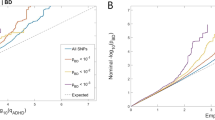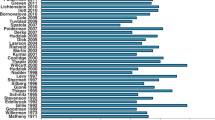Abstract
Although family, twin, and adoption studies indicate that attention deficit hyperactivity disorder (ADHD) is a familial condition with a robust genetic component, molecular genetic studies of candidate genes have produced inconsistent findings. One of the challenges to elucidating the genetic architecture of ADHD is its potential genetic heterogeneity. Therefore, efforts are needed to identify etiologically homogenous subgroups of subjects with ADHD for use in genetic studies. The current article reviews evidence suggesting that parsing ADHD subjects based on comorbidity with conduct and bipolar disorders may yield familial subtypes that are suitable for genetic analyses.
Similar content being viewed by others
References and Recommended Reading
Lopez RE: Hyperactivity in twins. Can Psychiat Ass J 1965, 10:421–426.
Biederman J, Mick E, Faraone SV: Age-dependent decline of symptoms of attention deficit hyperactivity disorder: Impact of remission definition and symptom type. Am J Psychiatry 2000, 157:816–818.
Faraone SV, Biederman J, Spencer T, et al.: Attention deficit hyperactivity disorder in adults: an overview. Biol Psychiatry 2000, 48:9–20.
Mannuzza S, Klein RG, Bessler A, et al.: Adult outcome of hyperactive boys: educational achievement, occupational rank and psychiatric status. Arch Gen Psychiatry 1993, 50:565–576.
Barkley RA, Fischer M, Edelbrock CS, Smallish L: The adolescent outcome of hyperactive children diagnosed by research criteria: I. An 8-year prospective follow-up study. J Am Acad Child Adolesc Psychiatry 1990, 29:546–557.
Barkley R: Attention deficit hyperactivity disorder: long-term course, adult outcome, and comorbid disorders. Presented at NIH Consensus Development Conference; November 16th, 1998; Bethesda, MD.
Mannuzza S, Gittelman-Klein R, Horowitz-Konig P, Giampino TL: Hyperactive boys almost grown up: IV. Criminality and its relationship to psychiatric status. Arch Gen Psychiatry 1989, 46:1073–1079.
Barkley R, Guvremont D, Anastopoulos A, et al.: Driving-related risks and outcomes of attention deficit hyperactivity disorder in adolescents and young adults: a 3- to 5-year follow-up survey. Pediatrics 1993, 92:212–218.
Leibson CL, Katusic SK, Barbaresi WJ, et al.: Use and costs of medical care for children and adolescents with and without attention-deficit/hyperactivity disorder. JAMA 2001, 285:60–66.
Cantwell DP: Genetics of hyperactivity. J Child Psychol Psychiatry 1975, 16:261–264.
Morrison JR, Stewart MA: The psychiatric status of the legal families of adopted hyperactive children. Arch Gen Psychiatry 1973, 28:888–891.
Sprich S, Biederman J, Crawford MH, et al.: Adoptive and biological families of children and adolescents with ADHD. J Am Acad Child Adolesc Psychiatry 2000, 39:1432–1437.
Biederman J: Treatment of ADHD with an emphasis on stimulant medication. Presented at The evaluation and treatment of ADHD in pediatrics; October 28, 1997; Boston, MA.
Shaywitz SE, Cohen DJ, Shaywitz BA: The biochemical basis of minimal brain dysfunction. J Pediatrics 1978, 92:179–187.
Russell V, de Villiers A, Sagvolden T, et al.: Altered dopaminergic function in the prefrontal cortex, nucleus accumbens and caudate-putamen of an animal model of attention-deficit hyperactivity disorder: the spontaneously hypertensive rat. Brain Res 1995, 676:343–351.
Russell VA: The nucleus accumbens motor-limbic interface of the spontaneously hypertensive rat as studied in vitro by the superfusion slice technique. Neurosci Biobehav Rev 2000, 24:133–136.
de Villiers AS, Russell VA, Sagvolden T, et al.: Alpha 2-adrenoceptor mediated inhibition of [3H]dopamine release from nucleus accumbens slices and monoamine levels in a rat model for attention-deficit hyperactivity disorder. Neurochem Res 1995, 20:427–433.
Papa M, Berger DF, Sagvolden T, et al.: A quantitative cytochrome oxidase mapping study, cross-regional and neurobehavioural correlations in the anterior forebrain of an animal model of Attention Deficit Hyperactivity Disorder. Behav Brain Res 1998, 94:197–211.
King JA, Barkley RA, Delville Y, Ferris CF: Early androgen treatment decreases cognitive function and catecholamine innervation in an animal model of ADHD. Behav Brain Res 2000, 107:35–43.
Doyle A, Roe CM, Faraone SV: The genetics of attention deficit hyperactivity. Primary Psychiatry 2001, 8:65–71.
Faraone SV, Doyle A: Attention deficit hyperactivity disorder In Emery and Rimoin’s Principles and Practice of Medical Genetics, edn 4. Edited by Rimoin DL, Connor JM, Pyeritz RE. Philadelphia, PA: WB Saunders Company; 2001:In press. This article provides a brief but recent overview of the behavioral and molecular genetics literature on attention deficit hyperactivity disorder.
Sandbrink R, Hartmann T, Masters CL, Beyreuther K: Genes contributing to Alzheimer’s disease. Mol Psychiatry 1996, 1:27–40.
Cambien F, Poirier O, Lecerf L, et al.: Deletion polymorphism in the gene for angiotensin-converting enzyme is a potent risk factor for myocardial infarction. Nature 1992, 359:641–644.
Biederman J, Faraone SV, Keenan K, et al.: Further evidence for family-genetic risk factors in attention deficit hyperactivity disorder. Patterns of comorbidity in probands and relatives in psychiatrically and pediatrically referred samples. Arch Gen Psychiatry 1992, 49:728–738.
Faraone SV, Biederman J, Mick E, et al.: Family study of girls with attention deficit hyperactivity disorder. Am J Psychiatry 2000, 157:1077–1083.
Angold A, Costello J, Erkanli A: Comorbidity. J Child Psychol Psychiatry 1999, 40:57–87. This article provides an excellent review of the issue of comorbidity in child psychiatry. The authors present evidence to support that comorbidity in several common childhood disorders is not simply due to methodologic factors. They also discuss rates of comorbidity, the implications of comorbidity for nosology and the impact of comorbidity on psychopathology.
Caron C, Rutter M: Comorbidity in child psychopathology: concepts, issues and research strategies. J Child Psychol Psychiatry 1991, 32:1063–1080. Although older than the article on comorbidity cited as reference 26, this article provides a clear and comprehensive review of several potential causes of artifactual comorbidity and methods for assessing whether "true" comorbidity exists.
Biederman J, Newcorn J, Sprich S: Comorbidity of attention deficit hyperactivity disorder with conduct, depressive, anxiety, and other disorders. Am J Psychiatry 1991, 148:564–577.
West S, McElroy S, Strakowski S, et al.: Attention deficit hyperactivity disorder in adolescent mania. Am J Psychiatry 1995, 152:271–274.
Borchardt CM, Bernstein GA: Comorbid disorders in hospitalized bipolar adolescents compared with unipolar depressed adolescents. Child Psychiatry Hum Dev 1995, 26:11–18.
Biederman J, Faraone SV, Mick E, et al.: Attention deficit hyperactivity disorder and juvenile mania: an overlooked comorbidity? J Am Acad Child Adolesc Psychiatry 1996, 35:997–1008.
Davis RE: Manic-depressive variant syndrome of childhood: preliminary report. Am J Psychiatry 1979, 136:702–706.
Carlson GA: Bipolar Affective disorders in childhood and adolescence. In Affective Disorders in Childhood and Adolescence. Edjted by Cantwell DP, Carlson GA. New York: Spectrum Publications; 1983:61–83.
Carlson GA: Classification issues of bipolar disorders in childhood. Psychiatr Dev 1984, 2:273–285.
Kutcher SP, Marton P, Korenblum M: Relationship between psychiatric illness and conduct disorder in adolescents. Can J Psychiatry 1989, 34:526–529.
Kovacs M, Pollock M: Bipolar disorder and comorbid conduct disorder in childhood and adolescence. J Am Acad Child Adolesc Psychiatry 1995, 34:715–723.
Wozniak J, Biederman J, Kiely K, et al.: Mania-like symptoms suggestive of childhood onset bipolar disorder in clinically referred children. J Am Acad Child Adolesc Psychiatry 1995, 34:867–876.
Geller B, Fox L, Clark K: Rate and predictors of prepubertal bipolarity during follow-up of 6-to 12-year-old depressed children. J Am Acad Child Adolesc Psychiatry 1994, 33:461–468.
Faraone SV, Biederman J, Mennin D, Russell RL: Bipolar and antisocial disorders among relatives of ADHD children: parsing familial subtypes of illness. Neuropsychiatr Genet 1998, 81:108–116.
Carlson GA, Bromet EJ, Jandorf L: Conduct disorder and mania: what does it mean in adults. J Affect Disord 1998, 48:199–205.
Milberger S, Biederman J, Faraone SV, et al.: Attention deficit hyperactivity disorder and comorbid disorders: issues of overlapping symptoms. Am J Psychiatry 1995, 152:1793–1800.
Biederman J, Newcorn J, Sprich S: Comorbidity in attention deficit hyperactivity disorder. In Task Force on DSM-IV: Source Book for DSM-IV. Washington, DC: American Psychiatric Association; 1990:145–162.
Biederman J, Faraone SV, Keenan K, Tsuang MT: Evidence of familial association between attention deficit disorder and major affective disorders. Arch Gen Psychiatry 1991, 48:633–642.
Biederman J, Faraone SV, Keenan K, et al.: Familial association between attention deficit disorder and anxiety disorders. Am J Psychiatry 1991, 148:251–256.
Biederman J, Faraone SV, Lapey K: Comorbidity of diagnosis in attention deficit hyperactivity disorder (ADHD). Child Adolesc Psychiatr Clin North Am 1992, 1:335–360.
Faraone SV, Biederman J, Keenan K, Tsuang MT: A familygenetic study of girls with DSM-III attention deficit disorder. Am J Psychiatry 1991, 148:112–117.
Faraone SV, Biederman J, Keenan K, Tsuang MT: Separation of DSM-III attention deficit disorder and conduct disorder: evidence from a family-genetic study of American child psychiatric patients. Psychol Med 1991, 21:109–121.
American Psychiatric Association: Diagnostic and Statistical Manual of Mental Disorders, edn 4. Washington, DC: American Psychiatric Association, 1994.
World Health Organization: ICD-10: Draft of Chapter V-Mental, Behavioural and Developmental Disorders. Presented at 1988 [AU: PLEASE COMPLETE REFERENCE].
Faraone S, Biederman J, Garcia Jetton J, Tsuang M: Attention deficit disorder and conduct disorder: longitudinal evidence for a familial subtype. Psychol Med 1997, 27:291–300.
Faraone SV, Biederman J, Chen WJ, et al.: Genetic heterogeneity in attention deficit hyperactivity disorder: gender, psychiatric comorbidity and maternal ADHD. J Abnorm Psychol 1995, 104:334–345.
August GJ, Stewart MA: Familial subtypes of childhood hyperactivity. J Nerv Ment Dis 1983, 171:362–368.
Faraone S, Biederman J, Mennin D, et al.: Familial subtypes of attention deficit hyperactivity disorder: a 4-year follow-up study of children from antisocial-ADHD families. J Child Psychol Psychiatry 1998, 39:1045–1053.
Szatmari P, Boyle M, Offord D: Familial aggregation of emotional and behavioral problems of childhood in the general population. Am J Psychiatry 1993, 150:1398–1403.
Silberg J, Rutter M, Meyer J, et al.: Genetic and environmental influences on the covariation between hyperactivity and conduct disturbance in juvenile twins. J Child Psychol Psychiatry 1996, 37:803–816.
Faraone SV, Biederman J, Monuteaux MC: Attention-deficit disorder and conduct disorder in girls: evidence for a familial subtype. Biol Psychiatry 2000, 48:21–29.
Pauls DL, Towbin KE, Leckman JF, et al.: Gilles de la Tourette’s Syndrome and obsessive-compulsive disorder: Evidence supporting a genetic relationship. Arch Gen Psychiatry 1986, 43:1180–1182.
Pauls DL, Hurst CR, Kruger SD, et al.: Gilles de la Tourette’s syndrome and attention deficit disorder with hyperactivity: Evidence against a genetic relationship. Arch Gen Psychiatry 1986, 43:1177–1179.
Faraone SV, Biederman J, Mennin D, et al.: Attention-deficit hyperactivity disorder with bipolar disorder: a familial subtype? J Am Acad Child Adolesc Psychiatry 1997, 36:1378–1387.
Faraone SV, Biederman J, Monuteaux MC: Attention deficit hyperactivity disorder with bipolar disorder in girls: further evidence for a familial subtype? J Affect Disord 2001, 64:19–26.
Biederman J, Faraone SV, Wozniak J, Monuteaux MC: Parsing the association between bipolar, conduct, and substance use disorders: a familial risk analysis. Biol Psychiatry 2000, 48:1037–1044. These findings support previous results documenting that when bipolar disorder and conduct disorder occur comorbidly, both are validly diagnosed disorders. This article also addresses the link between these conditions and substance use disorders.
Faraone SV, Biederman J, Monuteaux MC: Toward guidelines for pedigree selection in genetic studies of attention deficit hyperactivity disorder. Gen Epi 2000, 18:1–16.
Author information
Authors and Affiliations
Rights and permissions
About this article
Cite this article
Doyle, A.E., Faraone, S.V. Familial links between attention deficit hyperactivity disorder, conduct disorder, and bipolar disorder. Curr Psychiatry Rep 4, 146–152 (2002). https://doi.org/10.1007/s11920-002-0049-y
Issue Date:
DOI: https://doi.org/10.1007/s11920-002-0049-y




